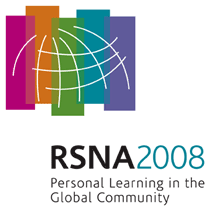
Abstract Archives of the RSNA, 2008
Minh Tam Truong MD, Abstract Co-Author: Nothing to Disclose
Jimmy Wenje Wang MD, Abstract Co-Author: Nothing to Disclose
Naoko Saito MD, Presenter: Nothing to Disclose
Al Ozonoff PhD, Abstract Co-Author: Nothing to Disclose
Julie Sullivan RT, Abstract Co-Author: Nothing to Disclose
Osamu Sakai MD, Abstract Co-Author: Nothing to Disclose
To evaluate the clinical use of CT perfusion (CTP) imaging during the course of definitive radiotherapy (RT) for head and neck cancer.
Patients with biopsy proven primary head and neck cancer undergoing primary RT with or without chemotherapy with curative intent were eligible for the study. Patients were treated to a total dose of 70-72 Gy with conformal RT over 6-7 weeks. Contrast enhanced CTs with CTP were obtained at baseline, weeks 2,4 and 6 of RT, and 6 weeks after RT. Perfusion parameters including Blood Flow (BF), blood volume (BV), mean transit time (MTT) and capillary permeability (CP) were determined in the tumor using a deconvolution-based analysis using the GE Medical Systems software package. The data was processed into maps that correspond to MTT (seconds), BV (ml/100g), BF (ml/100g/min), and CP (ml/100g/min). Clinical response was evaluated after RT.
Seven patients underwent 5 serial CTP studies according to protocol. Primary tumor sites included: oropharynx (2 patients), larynx (2), oral cavity (1), nasopharynx (1), auricle (1). Six of 7 patient received concurrent chemotherapy. Five of the 7 patients achieved a complete clinical response and 2 patients a partial response. At baseline (prior to RT), the mean BF, BV, MTT, and CP values in the primary tumor were 105.4 ml/100g/min, 6.13ml/100g, 5.31 seconds, 14.27 ml/100g/min respectively. At 6 weeks post RT, the corresponding mean CTP parameters were 83.79ml/100g/min, 5.1413ml/100g, 5.81 seconds and 18.325ml/100g/min. At weeks 2,4 and 6 of RT, the CTP parameters expressed a percentage of the baseline parameters demonstrated BF and BV increased 167% and 154% respectively from baseline at a median of 4 weeks into RT. MTT increased 146% from baseline at a median of 6 weeks of RT, CP increased 150% from baseline at a median of 2 weeks into RT. Decrease in perfusion parameters during RT for BF, BV, MTT and CP were 36%, 52%, 59% and 22% of the pre RT values respectively.
Our pre and post RT CTP parameters are similar to the published literature. During a course of definitive RT, CTP parameters are found to fluctuate with increases in BF, BV, MTT and CP during RT. Changes in CTP parameters may reflect changes in vascularity of the tumor in response to RT.
CTP may provide useful adjunct to diagnostic CT to assess tumor vascularity changes in response to RT.
Truong, M,
Wang, J,
Saito, N,
Ozonoff, A,
Sullivan, J,
Sakai, O,
Evaluation of CT Perfusion Imaging of Head and Neck Cancer during a Course of Radiotherapy. Radiological Society of North America 2008 Scientific Assembly and Annual Meeting, February 18 - February 20, 2008 ,Chicago IL.
http://archive.rsna.org/2008/6014889.html

